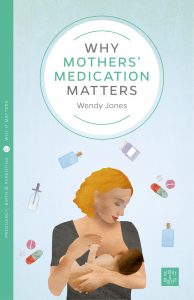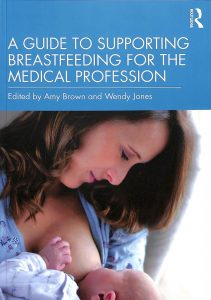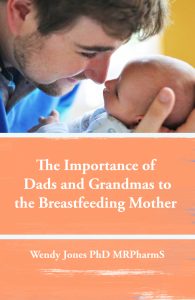So many mums seem to injure their backs – maybe we need antenatal classes on how to lift your baby (and equipment!) or more assessment of post-natal damage. When pain has not resolved with simple painkillers (paracetamol and ibuprofen (taken regularly and at full dose) sometimes further treatment is necessary from professionals. This may help the mother access physiotherapy or other mobility treatment.
Information here on how to treat the pain of acute back injury and relieve the spasm. I hope that it aids mothers and professionals.
Breastfeeding and pain relief for acute back injury
Non- steroidal analgesia
Normally mothers have taken ibuprofen along with paracetamol and may have found the pain has not resolved. I would suggest changing ibuprofen to naproxen or diclofenac to see if that helps. Both are compatible with breastfeeding. They should be taken with food and may be co-prescribed with omeprazole to protect the mother’s stomach from gastric bleed. The omeprazole is largely destroyed in the maternal gut and does not impact on breastfeeding. See https://www.sps.nhs.uk/articles/using-nsaids-during-breastfeeding
Muscle spasm
Muscle spasm relief can be achieved by the use of cold packs or heat packs. Topical rubs containing NSAIDS (Volatrol ®, Ibuleve®, PhorPain ®, Fenbid® etc) can be used with paracetamol. Ribs which produce warming or cooling can also provide relief along with massage to the area (Deep Heat ®, Tiger Balm®, Algesal® etc)
Up to a maximum of three days of diazepam 2mg 2-3 times a day to relive the spasm is also regularly used. It doesn’t seem to cause any problems used short term like this despite the long half-life. This is normally long enough to access some physio or other exercise regime. The evidence for this is largely anecdotal and based on my professional experience over the past 20 years. (Hale TW Medications and Mother’s Milk “Some reports of lethargy, sedation, and poor suckling have been found. The acute use such as in surgical procedures is not likely to lead to significant accumulation.”
Opiate pain relief
If greater pain relief is required, tramadol, Oramorph or dihydrocodeine are all breastfeeding compatible options.
- Dihydrocodeine or co dydramol is widely used post c section and is now the opiate analgesic of choice due to the fact that it has a cleaner metabolism.
- Morphine has extensive first pass metabolism so actually reaches low levels in milk. Oramorph is widely used
- Tramadol reaches low levels in babies but can make mum very sleepy. Watch the baby for signs of drowsiness too.
Constipation
If you take co-dydramol or oramorph or any opioid you will need a laxative like lactulose, bisacodyl or dioctyl all of which you can buy from a pharmacy, See https://breastfeeding-and-medication.co.uk/fact-sheet/constipation-laxatives-and-breastfeeding
The following data is extracted from my book Breastfeeding and Medication 2018
Co-dydramol – paracetamol 500 mg and dihydrocodeine 10 mg.
Preferred compound analgesic due to cleaner metabolism than codeine. Use for as short a time as possible. Observe baby for drowsiness. If baby becomes drowsy stop drug immediately and seek medical advice.
Tramadol
Tramadol is an opiate analgesic used for moderate to severe pain. Its use would appear to have increased as a result of concern over codeine preparations. It is subject to first-pass metabolism. It has an elimination half-life of six hours. Tramadol inhibits the reuptake of noradrenaline and serotonin and may potentiate the action of other drugs with similar action, e.g. SSRI anti-depressants.
Ilett et al. (2008) studied 75 breastfeeding mothers who were given 100 mg tramadol post-caesarean section on days two–four. They collected milk and plasma samples of four or more doses to reflect steady state. Additionally, he observed the infants together with matched controls not exposed to tramadol. He determined a relative infant dose quoted as 2.24% for tramadol and 0.64% for its metabolite. No difference was noted in the behaviours of the infants exposed compared with the controls and the authors therefore concluded that short-term maternal use of tramadol is compatible with breastfeeding.
In 2015 the FDA recommended that tramadol is not used in breastfeeding mothers. When tramadol is taken, it is changed in the liver to O-desmethyltramadol (known as M1). Both tramadol and M1 relieve pain and are responsible for side effects that some people may experience, but M1 has stronger opioid effects than the tramadol. Tramadol is metabolised in the liver by enzyme cytochrome P450 isoenzyme 2D6 (CYP2D6). Some people have a variation of this enzyme that changes codeine to morphine and tramadol to M1 faster and to a greater extent than in other people. These individuals are called CYP2D6 ultra-rapid metabolisers. Just as in codeine, this can produce an accumulation of the drug in breastmilk. This genotype is present in up to 10% of the white population in Europe and North America, but only 4% of black African Americans (FDA 2015).
As with other opiates, exposure of premature infants should be undertaken with caution because of the risk of apnoea and sedation. Amount probably too small to be harmful, but manufacturer advises avoidance (BNF).
Avoid if possible although the amount in breastmilk is probably too small to be harmful. Use for as short a time as possible. Observe baby for drowsiness. If baby becomes drowsy stop drug immediately and seek medical advice.
- FDA, Use of Codeine and Tramadol Products in Breastfeeding Women, FDA, 2015.
- Ilett KF, Paech MJ, Page-Sharp M, Sy SK, Kristensen JH, Goy R, Chua S, Christmas T, Scott KL, Use of a sparse sampling study design to assess transfer of tramadol and its o-desmethyl metabolite into transitional breastmilk, Br J Clin Pharmacol, 2008;65(5):661–6.
Morphine
Therapeutic doses of morphine in the breastfeeding mother are unlikely to be harmful to baby in the short term, e.g. post-operatively. Infants under 4 weeks of age have a prolonged elimination half-life and clearance does not approach adult levels until 2 months of age. Respiratory difficulties may be important to be aware of with premature babies or others at risk of apnoea. The oral absorption of morphine is very poor and first-pass metabolism is high. It is therefore frequently used post-caesarean section as Oramorph solution.
Robieux et al. (1990) reported a single case of an infant who was breastfed while his mother was receiving low doses of morphine. Morphine concentration in his serum was in the analgesic range (4 ng per millilitre), while concentrations in the milk varied substantially from 10–100 ng per millilitre. The authors calculated that the baby had received 0.8–12% of the maternal dose. Oberlander et al. (2000) studied one baby born to a mother who received morphine intrathecally during and after pregnancy. Minimal levels were determined in breastmilk over seven weeks and the infant’s development and feeding up to seven months were normal. Baka et al. (2002) also studied women receiving patient-controlled analgesia post-caesarean section and noted that the concentrations of morphine in breastmilk were very small (<1 to 274 ng per millilitre) with a m/p ratio <1. Relative infant dose is quoted as 9.1% (Hale 2017 online access). Therapeutic doses unlikely to affect infant (BNF).
Compatible with use short term during breastfeeding. Observe baby for sedation and poor feeding.
References
- Baka NE, Bayoumeu F, Boutroy MJ, Lexenaire MC, Colostrum morphine concentrations during postcesarean intravenous patient-controlled analgesia, Anesth Analog, 2002;94:184–7.
- Ilett KF, Paech MJ, Page-Sharp M, Sy SK, Kristensen JH, Goy R, Chua S, Christmas T, Scott KL, Colostrum morphine concentrations during postcesarean intravenous patient-controlled analgesia, Anesth Analg, 2002;94:184–7.
- Oberlander TF, Robeson P, Ward V, Huckin RS, Kamani A, Harpur A, McDonald W, Prenatal and breastmilk morphine exposure following maternal intrathecal morphine treatment, J Hum Lact, 2000;16:137–42.
- Robieux I, Koren G, Vandenbergh H, Schneiderman J, Morphine excretion in breastmilk and resultant exposure of a nursing infant, J Toxicol Clin Toxicol, 1990;28:365–70.
- Naproxen
- Naproxen is more than 99% bound to plasma proteins. Davies and Anderson (1997) reported that although naproxen is excreted into breastmilk, the amount of drug transferred comprises only a small fraction of the maternal exposure. In Jamali and Stevens’ study (1983) only 0.26% of the mother’s dose was recovered from the infant and adverse effect reports are low. However, this drug has a longer half-life than other NSAIDs, normally being taken only twice a day. The BNF considers that the amount of naproxen distributed into breastmilk is too small to be harmful to a breastfed infant; however, some manufacturers recommend that breastfeeding should be avoided during naproxen therapy, due to licencing considerations rather than potential risk. Relative infant dose is quoted as 3.3% (Hale 2017 online access). The BNF states that the amount in breastmilk is too small to be harmful but that the manufacturer advises use should be avoided.
- Compatible with use during breastfeeding due to limited transfer into breastmilk.
- References
- Davies NM, Anderson KE, Clinical pharmacokinetics of naproxen, Clin Pharmacokinet, 1997;32:268–93.
- Jamali F, Stevens DRS, Naproxen excretion in milk and its uptake by the infant, Drug Intell Clin Pharm, 1983;17:910–11.
- Diclofenac
- Research studies are not widely documented as it is used less frequently in the USA than in the UK. However, the lack of reports of adverse effects suggests that there is little cause for concern. It has been one of the most widely used drugs in the immediate postpartum period in the UK but is now being replaced by naproxen because of the risk of cardio-vascular effects.
- Oral diclofenac is almost completely absorbed but it is subject to first-pass metabolism so less reached the systemic circulation. Its high plasma protein binding (in excess of 99%) limits its passage into breastmilk. It is widely used on post-natal wards. Relative infant dose is quoted as 1% (Hale 2017 online access). The BNF states that the amount present in breastmilk is too small to be harmful.
Compatible with use during breastfeeding due to limited transfer into breastmilk.
Omeprazole
Omeprazole is rapidly destroyed in acid conditions of the stomach below pH 4. It is also given to infants to treat severe gastric reflux. It is 95% bound to plasma proteins. It is not licenced for use in children below 1 year but is used outside of its licence application at a dose of 700 µg per kilogramme per day for reflux compared with an estimated dose through breastmilk of 3 µg per kilogramme per day passing through breastmilk in the study of one mother (Marshall et al. 1998). Hale 2017 (online access) quotes the relative infant dose as 0.02%.
Omeprazole suspension (unlicenced) is the only proton pump inhibitor liquid preparation available for administration to infants. This preparation is a ‘special’ and needs to be ordered by the pharmacy from a specials laboratory. However, it is not licenced for children under 1 year of age. It is metabolised by the cytochrome P450 system so potential interactions are possible. The BNF reports that it is present in milk but that it is not known to be harmful.
Compatible with breastfeeding as destroyed at pH <4. Used directly in children with severe gastro oesophageal reflux disease.
References
- Marshall JK, Thompson AB, Armstrong D, Omeprazole for refractory gastroesophageal reflux disease during pregnancy and lactation, Can J Gastroenterol, 1998;12:225–7.
- National Institute for Health and Care Excellence (NICE), Gastro-oesophageal reflux disease: recognition, diagnosis and management in children and young people (cks.nice.org.uk/gord-in-children).





